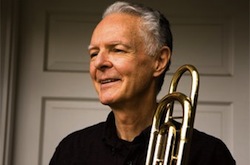Today’s discs are Stuart Dempster’s ‘Underground Overlays From The Cistern Chapel’, The Best of Os Mutantes and period instrument recordings of Mozart’s last four string quartets and late piano quartets.
I consider myself EXTREMELY lucky to know Stuart. He is quite possibly the most amazing musician I have ever had the chance to talk, listen to and learn from (though I don’t know how much Stuart knows this… so, just in case he is reading – Thanks Stuart!).
The ‘Cistern Chapel’ disc features Stuart and a number of musicians (including my friend Chad Kirby) that he taught and worked with in the Pacific Northwest recorded inside a huge underground water tank in Fort Warden, Washington. Every sound that is made in the cistern will echo for 35-45 seconds. The music on this disc includes trombones, didgeridoo, conch shells and voice. As every new sound is created, it is sustained as new material begins. The performers play the space in addition to their instruments. I find it strange now to say something like ‘the performers play the space in addition to their instruments’ since after hearing this disc, one of my big realizations as a musician is that a performer is ALWAYS playing the space in addition to their instruments. I remember how I would always have to make adjustments during performances once an audience was present or to adjust to a new space, but until I heard this disc is was something I did subconsciously, and certainly not something that I would have realized that I could play with. And it is still one of the biggest concerns (and joys) I have when performing electronic music.
I also have a string of pieces that were heavily influenced by the music on this disc. ‘Palimpsest’ for electric guitar was my first attempt to think of reverb and space as a compositional parameter and not just an effect. ‘Cadence’ for computer has the decay of sound (over 14 minutes) as it’s main concept. ‘Theta’ for viola is largely about making the performer resonate with themselves. And finally ‘Risonanza’ for computer, which was composed for the High Voltage Hall in Warsaw, Poland last year. The High Voltage Hall was a large, metallic cube that had a 30 second reverb time, and the piece was conceived for performance in that space and its unique qualities. ‘Space’ as a compositional concept, something to be shaped and controlled like melody or harmony, has become one of the most important aspects to my music. And it was Stuart’s disc that revealed the possibilities of musical space to me. This became one of my main topics of research for my doctoral exams, and it is still one of the most important areas of my work.
The music on ‘Cistern Chapel’ is often described as ambient, and I certainly understand this description. But what strikes me most about the disc is how much attention it draws from me when I listen to it. One might expect that once a sound plays and begins a 40 second decay, that there isn’t much more to hear beyond the space. But what you hear is how complex sound is and how timbre changes as energy dissipates. The result is a very dynamic and active music, constantly changing in ways that ‘more active’ music doesn’t. In most classical / pop music, there may be 1-5 notes of melody per second and harmony may change at a slightly slower pace. And it is these changes that usually draws our attention. But in the Cistern, there may only be one or two notes every 6-10 seconds, but the change is constant.
For those of you that haven’t heard of Os Mutantes, they are a psychedelic group from 1960s Brazil. They grab influence from ‘Sgt. Pepper’,’Electric Ladyland’, ‘Pet Sounds’, Bossa Nova and Latin Jazz. If you haven’t heard (or seen) them, do a quick search on YouTube and enjoy a couple songs. And I highly recommend their compilation ‘Anything Is Possible’ on David Byrne’s Luaka Bop label. ‘Fuga No. 11’ is my particular favorite.



